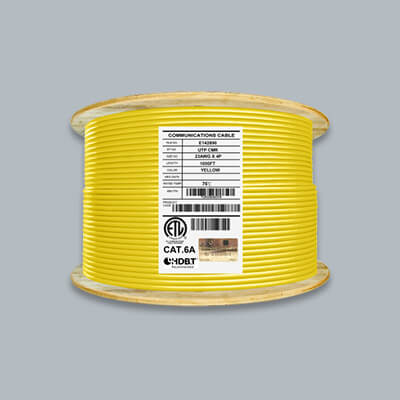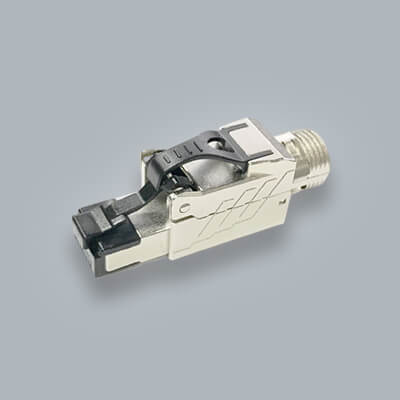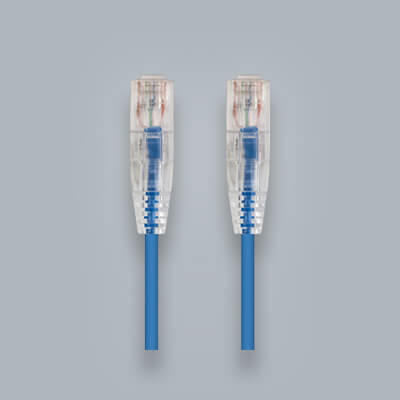Cat6 Ethernet Cable Facts

Table of Contents
- What Is The Maximum Supported Throughput Of A Cat6 Ethernet Cable?
- What Gauge Is Cat6?
- How Many Wires Are In Cat6?
- How Far Can You Run Cat6?
- What Types Of Cat6 Cabling Are There?
Intro
Cat6 ethernet cables are one of the most popular cables in the market today. They have a wide range of capabilities and different uses with one of the most popular uses being to create an internet connection. Whether using cable for your home network or business Cat6 cables can give your applications just what they need for a powerful setup. In this blog post we answer common questions for Cat6 cables.
What Is The Maximum Supported Throughput Of A Cat6 Cable?
The maximum supported throughput of a Cat6 cable is 10Gbps. It can achieve this speed up to 180 feet (55 meters). Cat6 however is specified by TIA standards for 1 gigabit ethernet and 250 MHz up to 328 feet. Getting higher speeds on Cat6 cables are not guaranteed but show you that the cable is capable of achieving these faster speeds at shorter distances. Not only can Cat6 cable get up to 10Gb but based on IEEE 802.3bz it can achieve 2.5GBase-T and 5GBase-T up to 328 feet (100 meters). Overall this is a great option for giving you fast speeds for majority of today's devices and can future proof you for years to come. Cat6 cables also give you higher bandwidth compared to previous categories.
What Gauge Is Cat6?
Cat6 ethernet cables have a gauge size that ranges from large to smaller. You can find Cat6 ethernet cables having a gauge size of 23, 24 and 28. They will be listed with (AWG) American Wire Gauge next to the number. This tells you the gauge size of the conductors in the cable. So if you see a 24AWG cable then this lets you know that the gauge size is 24.
Gauge sizes have an inverse relationship so the smaller the number the larger in size the conductors are and the larger the number the smaller the conductors. For example a 28AWG cable will have smaller conductors than a 24AWG cable.
How Many Wire Pairs Are In Cat6 Ethernet Cable?
Cat6 ethernet cables will have 8 copper wires inside them. They have 4 pairs of 2 copper wires surrounded in insulation material. The copper conductors are also twisted together for better performance against crosstalk. These wires are used to connect to modular RJ45 connectors, keystone jacks and patch panels. Each ethernet standard can require a different amount of the wires inside Cat6 cables.
10GBase-T requires 2 pairs
100Base-TX requires 2 pairs
1000Base-T requires 4 pairs
2.5GBase-T requires 4 pairs
5GBase-T requires 4 pairs
10GBase-T requires 4 pairs
How Far Can You Run Cat6?
The maximum length you can run Cat6 ethernet cable is 328 feet (100 meters). This is the distance that 1Gb and 250MHz can be run up to according to its standard set by TIA. This doesn't mean that you can run this further but it is absolutely not recommended. At longer distances on Cat6 cables signal strength can start to decrease and factors such as attenuation can happen, Keeping your Cat6 cable run shorter than 328 feet ensures that gigabit speeds can perform reliably.
At shorter distances you can expect high speeds. Running Cat6 ethernet cables under 180 feet gives you the opportunity to power 10Gb under ideal conditions. Not guaranteed but the proper equipment and good terminations gives you a great chance
What Types Of Cat6 Cabling Are There?
Cat6 ethernet cables can come in many different variations. The majority of different categories come with many different variations for different uses. Cat6 cable being one of the most popular categories gives you a large amount of options to choose from. The most common decisions for this ethernet cable will be unshielded or shielded cable types. Depending on the environment of your installation will determine which cable to go with. For more on shielded environment head on over to what is shielded cable? To be brief shielded cable is really for areas with EMI (Electromagnetic Interference). Unshielded Twisted Pair (UTP) cables are one of the most used for residential and commercial applications.
Not only are there differences in the structure of the cable but there is also different forms of the cable. You can get Cat6 ethernet cable in bulk cable and patch cable form. Bulk cables are great for custom installation around your home, commercial buildings, data centers and much more. Bulk lengths are often found in 1000 feet and 500 feet. Cat6 patch cables are great for shorter run installations. They are usually installed in to your end devices. This could be from your cable modem or router to your computer or from a wall jack to your Xbox. You can even connect a Cat6 patch cable from computer to computer using a crossover cable.
Conclusion
Cat6 cable is great cable for so many different applications. It can be used indoor, outdoor and in plenums. It comes in many different structures as well which make it suitable for almost any type of environment. We hope you found these Cat6 ethernet cable facts helpful! If there is anything you would like us to add please let us know!






Hello Mike, Thank you for contacting us. We’d be glad to help you in your request for a connector for your Cat6 ethernet cable. When you have a chance please contact us at support@infinity-cable.com
What is a good RJ45 connector to use on a cat 6, 550MHZ, 4 pairs 23AWG, solid bare copper, outer diameter 7.6 mm (+ – 0.10mm)
Shielded twisted pair, CMR rated (Riser)
062-505/S/GR
I’m using this cable for a residential security system and cameras.